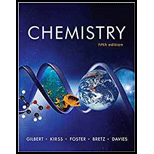
Concept explainers
Interpretation: The Lewis structure and shape of the given compound, the hybridization of the central atom and the resonating structure that has formal charge close to zero is to be identified.
Concept introduction: The Lewis structure represents all bonding and non-bonding electrons surrounding the atoms involved in a molecule. A molecule exhibits a particular geometry in space considering the steric hindrances of the bond pairs and the lone pairs of electron.
Resonance structures are different forms of a molecule in which the chemical connectivity of the atoms in a molecule is same but there distribution of electrons is different.
The formal charge is calculated by the formula,
To determine: The Lewis structure and shape of the given compound, the hybridization of the central atom and the resonating structure that has formal charge close to zero.
Answer to Problem 9.65QP
Solution
The Lewis structure of
The resonating structure I has formal charge close to zero.
The shape of the molecule is tetrahedral and the hybridization of the chlorine is
Explanation of Solution
Explanation
The
The electronic configuration of
The number of valence electrons of
The atomic number of
The electronic configuration of
The number of valence electrons of
The total number of valence electrons of
The Lewis structure of

Figure 1
Resonance structures are different forms of a molecule in which the chemical connectivity of the atoms in a molecule is same but there distribution of electrons is different.
The resonance structure of

Figure 2
The formal charge is calculated by the formula,
According to the I resonating structure of the given compound from figure 2,
- Chlorine has fourteen bonding and zero nonbonding electrons.
- Oxygen (a) has four bonding electrons and four nonbonding electrons.
- Oxygen (b) has two bonding and six nonbonding electrons.
- Oxygen (c) has four bonding electrons and four nonbonding electrons.
- Oxygen (d) has four bonding and four nonbonding electrons.
The formal charge of chlorine in resonating structure 1 is calculated as,
The formal charge of oxygen (a) in resonating structure 1 is calculated as,
The formal charge of oxygen (b) in resonating structure 1 is calculated as,
The formal charge of oxygen (c) in resonating structure 1 is calculated as,
The formal charge of oxygen (d) in resonating structure 1 is calculated as,
According to the II resonating structure of the given compound from figure 2,
- Chlorine has twelve bonding and zero nonbonding electrons.
- Oxygen (a) has two bonding electrons and six nonbonding electrons.
- Oxygen (b) has two bonding and six nonbonding electrons.
- Oxygen (c) has four bonding electrons and four nonbonding electrons.
- Oxygen (d) has four bonding and four nonbonding electrons.
The formal charge of chlorine in resonating structure 1 is calculated as,
The formal charge of oxygen (a) in resonating structure 1 is calculated as,
The formal charge of oxygen (b) in resonating structure 1 is calculated as,
The formal charge of oxygen (c) in resonating structure 1 is calculated as,
The formal charge of oxygen (d) in resonating structure 1 is calculated as,
According to the II resonating structure of the given compound from figure 2,
- Chlorine has fourteen bonding and zero nonbonding electrons.
- Oxygen (a) has four bonding electrons and six nonbonding electrons.
- Oxygen (b) has two bonding and six nonbonding electrons.
- Oxygen (c) has four bonding electrons and six nonbonding electrons.
- Oxygen (d) has four bonding and four nonbonding electrons.
The formal charge of chlorine in resonating structure 1 is calculated as,
The formal charge of oxygen (a) in resonating structure 1 is calculated as,
The formal charge of oxygen (b) in resonating structure 1 is calculated as,
The formal charge of oxygen (c) in resonating structure 1 is calculated as,
The formal charge of oxygen (d) in resonating structure 1 is calculated as,
According to the IV resonating structure of the given compound from figure 2,
- Chlorine has ten bonding and zero nonbonding electrons.
- Oxygen (a) has two bonding electrons and six nonbonding electrons.
- Oxygen (b) has two bonding and six nonbonding electrons.
- Oxygen (c) has two bonding electrons and six nonbonding electrons.
- Oxygen (d) has four bonding and four nonbonding electrons.
The formal charge of chlorine in resonating structure 1 is calculated as,
The formal charge of oxygen (a) in resonating structure 1 is calculated as,
The formal charge of oxygen (b) in resonating structure 1 is calculated as,
The formal charge of oxygen (c) in resonating structure 1 is calculated as,
The formal charge of oxygen (d) in resonating structure 1 is calculated as,
Resonating structure 1 has formal charge close to zero
The molecular shape of
From the resonating structure I it is concluded that the chlorine atom forms three pi bonds this means it uses three
Conclusion
The Lewis structure of
The resonating structure I has formal charge close to zero.
The shape of the molecule is tetrahedral and the hybridization of the chlorine is
Want to see more full solutions like this?
Chapter 9 Solutions
CHEMISTRY:SCI.IN CONTEXT (CL)-PACKAGE
 ChemistryChemistryISBN:9781305957404Author:Steven S. Zumdahl, Susan A. Zumdahl, Donald J. DeCostePublisher:Cengage Learning
ChemistryChemistryISBN:9781305957404Author:Steven S. Zumdahl, Susan A. Zumdahl, Donald J. DeCostePublisher:Cengage Learning ChemistryChemistryISBN:9781259911156Author:Raymond Chang Dr., Jason Overby ProfessorPublisher:McGraw-Hill Education
ChemistryChemistryISBN:9781259911156Author:Raymond Chang Dr., Jason Overby ProfessorPublisher:McGraw-Hill Education Principles of Instrumental AnalysisChemistryISBN:9781305577213Author:Douglas A. Skoog, F. James Holler, Stanley R. CrouchPublisher:Cengage Learning
Principles of Instrumental AnalysisChemistryISBN:9781305577213Author:Douglas A. Skoog, F. James Holler, Stanley R. CrouchPublisher:Cengage Learning Organic ChemistryChemistryISBN:9780078021558Author:Janice Gorzynski Smith Dr.Publisher:McGraw-Hill Education
Organic ChemistryChemistryISBN:9780078021558Author:Janice Gorzynski Smith Dr.Publisher:McGraw-Hill Education Chemistry: Principles and ReactionsChemistryISBN:9781305079373Author:William L. Masterton, Cecile N. HurleyPublisher:Cengage Learning
Chemistry: Principles and ReactionsChemistryISBN:9781305079373Author:William L. Masterton, Cecile N. HurleyPublisher:Cengage Learning Elementary Principles of Chemical Processes, Bind...ChemistryISBN:9781118431221Author:Richard M. Felder, Ronald W. Rousseau, Lisa G. BullardPublisher:WILEY
Elementary Principles of Chemical Processes, Bind...ChemistryISBN:9781118431221Author:Richard M. Felder, Ronald W. Rousseau, Lisa G. BullardPublisher:WILEY





